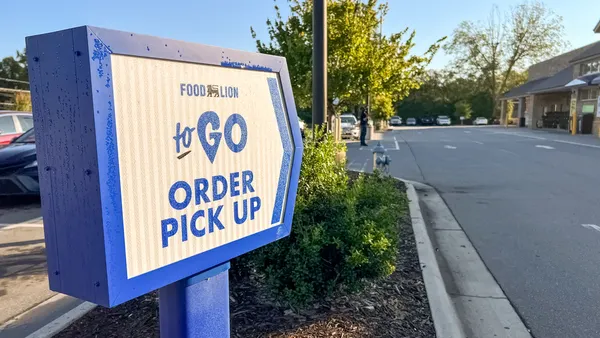Dive Brief:
- Walmart is dominating omnichannel grocery shopping, a new report from Packaged Facts finds. Among those surveyed, about 27% of in-store grocery purchasers say Walmart is the retailer they get groceries from most, with Kroger coming in second. Of those who reported shopping by click-and-collect, about 42% identified Walmart as the outlet for their last pickup order, which is three times the number of shoppers who made a click-and-collect purchase at runner-up Target.
- The report also found that when choosing to purchase groceries online at one place over another, shoppers cited cost as a key driver, with 41% citing free delivery and 40% citing lower prices.
- In a previous report, Packaged Facts found that almost 59% of grocery shoppers have purchased groceries from Walmart in last 3 months, with 58% purchasing in-store and 5% purchasing online.
Dive Insight:
The outlook is merry for Walmart heading into the holidays. The white-hot retailer has officially gained recognition as the largest grocer in the country, according to Packaged Facts, which found that grocery and consumables made up 56% of Walmart’s U.S. net sales in the last five years. Walmart is well aware of its momentum in grocery. In its recent third-quarter earnings, which saw revenue increase to reach almost $125 billion, the company attributed much of its recent growth to omnichannel grocery sales.
A number of recent initiatives have helped Walmart reach its leading status, including rapid expansion of both delivery and click-and-collect, as well as improved brick-and-mortar experiences. Walmart is also investing in experimental efforts to help streamline delivery and simplify e-commerce. The company is piloting driverless delivery with Ford and Postmates, building a tech-enabled grocery distribution center to serve 200 stores in California, and experimenting with a pickup-only location in Chicago.
Walmart’s click-and-collect strategy plays a significant role in its growing grocery dominance. Packaged Facts forecasts Walmart’s click-and-collect grocery sales to grow at a 154% average annual rate from 2017 through 2021, driving total Walmart U.S. e-commerce sales, and come the end of January, Walmart will have 2,100 locations enabled for click-and-collect grocery service.
Similar intensity is at play for grocery delivery, with Walmart planning to have 800 locations ready for online grocery delivery to reach more than 40% of U.S. households by the end of January, the report found. Between its click-and-collect and online grocery efforts, Walmart is poised to reach a majority of Americans with just the click of a button —something few retailers can boast.
The company’s grocery e-commerce is heavily fueled by its desire to compete with Amazon, which is the online grocery leader but is struggling to make grocery profitable. Packaged Facts found that 38% of online grocery purchasers say they use Amazon most for groceries, followed by Walmart at 23%, but Walmart is gaining steam. Another recent survey from the Retail Feedback Group found that Walmart surpassed Amazon as the online grocer of choice among consumers, and that sentiment — as well as Walmart’s growing share in online grocery — is a serious challenge to Amazon. Regardless of what moves either of these retail giants makes in the coming months, consumer behavior is going to ultimately decide who is the real winner.
Despite Packaged Facts’ findings, other analysts are seeing promising returns from retailers outside of the big two. A report from Brick Meets Click released last month rated Target over Walmart as the leader in omnichannel grocery shopping experience, and suggested that Walmart could simplify its offerings across online and offline channels. But while leadership can be measured differently throughout the industry, there’s no question that Walmart is in a strong position and can expect ongoing success.













